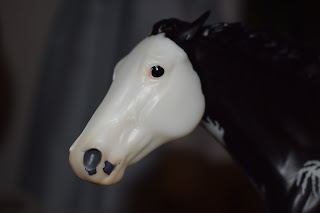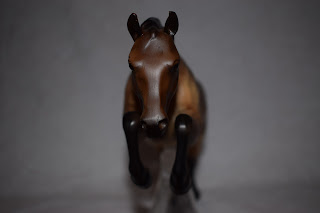Hi all,
This is a guide to your first model horse show, this is specifically to help people coming to my model horse show in August if it's their first time coming to a live show! I will also be doing a get ready with me: model horse show edition and ways to get into the model horse hobby.
But lets not get ahead of ourselves and dive into live show survival!!
Plan and plan and more planning
I can't stress enough how much you need to plan! Don't leave stuff to the last minute or god forbid the day of the show! I really enjoy planing so this is lots of fun for me but others may not enjoy it as much so do it early so you have less to worry about at the show.
Before the show you should have:
1. Your model show string picked out: these are your best models, the ones in the best condition, have the best shading, have good conformation etc. Model horses are judged at live shows on their conformation, whether they are correct for the breed assigned and if they are biomechanically correct; in terms of model horses this basically means if it was a real horse would it be able to walk around and not be in pain because of its structure, be that bone or muscle structure.
Whilst condition is not the first thing a judge looks at, they will certainly use it to decide between two of the same model or between different places. So if you have to choose between a horse with ear rubs or shiny marks and a horse without these flaws the second horse will most likely place higher than the marked horse.
2. Breeds assigned: Model horse show classes are divided by different breeds or breed type such as Arabian class, shire class and British native breeds class.
This means you must have assigned a breed to each of your horses in your show string and they should go into each class according to the breed you assigned.
Finding breeds for your horses can be tricky, it takes a lot of research to find breeds that match your horses colour, body type and conformation.
Here are a few ways you can research breeds:
- Use Breyer/other model brands original breed. This works well for some horses, for instance I show my Breyer Valegro as a Dutch Warmblood, this is the actual breed Valegro is so he fits the colour standards and conformation standards for a Dutch Warmblood. He got a 2nd in my first show!
- However some breeds Breyer assigns are not very good or the model gets shown as that a lot, like the Smarty Jones mould being shown as a thoroughbred, you want your horse to stand out! So research them online, use breeder websites and breed associations websites to get a good, reliable look at what the breed looks like and its characteristics.
- Be old fashioned, use books! Breed books are an excellent source for breed characteristics and rules. They are great as they have all been fact checked unlike some internet sites. However they usually don't have as many photos as breeder websites.
I am going to give an example of how I would research a breed for one of my horses.
This is Luke, my Breyer polo pony on the Smarty Jones mould.
I want to show Luke as a Polo Pony as he has the roached mane and the wrapped tail synonymous with a Polo Pony. However Polo Pony is not a breed, they are usually a mix of many different horses and ponies and sometimes aren't even the correct height and conformation to be a pony!
I first do some research on Polo Ponies:
https://en.wikipedia.org/wiki/Polo
http://www.polomuseum.com/sport-polo/history-polo
http://www.theequinest.com/breeds/argentine-polo-pony/
From my research I gather that polo ponies are usually crossbreeds of Thoroughbreds, Argentinian Criollo horses and stock horses.
I look at my horse and his characteristics; he's grey so he can be a thoroughbred, quarter horse, Australian stock horse and Criollo. He has big hindquarters and is quite lean and his back is quite short.
So after looking into some of these crossbreeds with my horses characteristics in mind I settle on a thoroughbred X Australian stock horse! I then write a reference for him. (I'll cover references in the next part of this post) and Ta Dah! Your horse is ready to go!
3.Breed cards and references: So you probably now have a good list of all your models you want to bring to the show and hopefully a breed assigned to each horse. You know need to make each horse a 'breed card' this card you will put down in front of the horse when its in the show ring to let the judge know your horses breed and its gender. You should NOT put your name or your horses name on the same side of the card as the breed and gender. This could cause bias in the judging if someone was family/friend of the judge. So each model is more or less anonymous. You can put your name on the under side of the card, this can be helpful if there is two of the same horse in the ring, so as they don't get mixed up.
A reference is only given to a unusual cross breed (ie clydesdale X quarter horse) or a rare or unusual breed (ie Kerry Bog pony). I would usually list my horses in a note book with their assigned breed beside their name and put a little 'r' next to any horses I think will need a reference to remind me to make one for them.
Here is how I make my references.
Using Luke the polo pony as an example again, as he is a bit of an usual crossbreed I have decided to write him a reference.
First I describe briefly the desirable characteristics found in a polo pony. I give a sentence on their characteristics, a sentence on their appearance (roached mane and tail wrap) and a sentence on their odd height for being a pony. You want to keep it short and simple, steer away from quoting all of Wikipedia or using super technical language, as the judge either won't read it or won't understand it!
I then introduce the cross of Australian stock horse and thoroughbred being a common cross for polo ponies. I then say one to two sentences about both breeds and leave it at that. Main things you want to mention are the colours the breed can be, the body type and their height. If they have a very unusual trait like Marwari's curled ears you will also want to mention this.
4.Packing: This is usually the last stage of prep, I suggest doing this during the week before your show, so you spend enough time properly packing them. This stops any accidents happening in transit to the show.
Depending on how far you are travelling to the show you may need to pack differently, if you are going by plane or train or boat a long distance I suggest getting a suitcase and lining it in foam, then use the next method to wrap your horses up so they don't get broken whilst travelling. I myself have not traveled by plane with models (yet) and am not sure I would trust them going in the hold. If you can take them on as cabin luggage I think this would be safer.
To pack your horses for a show you should first give them a bath! This gets any dust or dirt off of them and makes them look their best for the big day. Luke warm water and a bit of soap does the trick.
I then suggest wrapping heads, any protruding legs and tails up separately with bubble wrap. Then wrap the horse entirely in bubble wrap. I usually do three layers thick just to be safe. Make sure you wrap the horse with the bubbles to the OUTSIDE this means if there is high temperatures while the horses are being transported you won't get plastic melting onto them which is extremely hard to fix.
Now put them snugly in a case or box. Most collectors use big plastic storage containers found in hardware shops to transport their models. Make sure none of the horses are loose to to rattle around while moving, if you have gaps between the horses fill these with soft blankets or towels to prevent the model from moving.
And now you're ready to go! I hope this guide was helpful and keep an eye out for the next few articles on model horse showing.






















